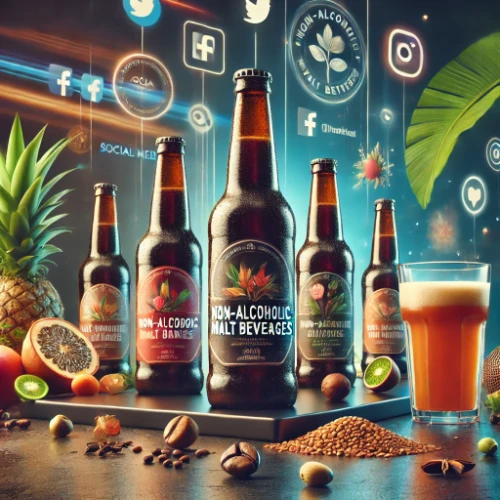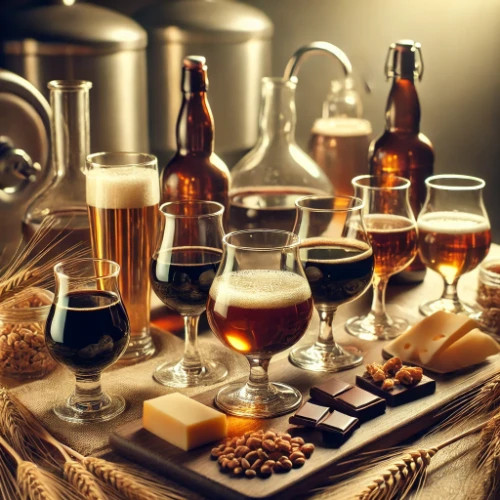Malt drinks in Africa are rapidly gaining popularity, driven by changing consumer preferences and health trends. Despite limited attention in global reports, malt drinks form a significant part of the non-alcoholic beverage industry across the continent. Africa, especially markets like Nigeria and Egypt, is emerging as a stronghold for these beverages. Innovation, competition, and consumer demand continue to shape this exciting market.
This article delves into the factors contributing to the rise of malt drinks in Africa. We will explore how health-conscious consumers are embracing them, the major players leading the market, and how new flavors and packaging innovations are driving growth.
Why Malt Drinks Are Thriving in Africa
A key reason for the boom in malt drinks in Africa is the growing preference for non-alcoholic beverages. More people are moving away from alcoholic drinks, and malt beverages offer a familiar alternative. Malt drinks use similar ingredients to beer—such as barley—but without alcohol. This gives them a familiar flavor but makes them suitable for all ages and regions. In Islamic countries like Egypt, where alcohol consumption is restricted, malt drinks have found a strong consumer base. They offer refreshment without the social and religious concerns attached to alcohol.
But beyond the cultural acceptance, malt drinks appeal to consumers because they are marketed as healthier than sugary sodas. This trend has played a crucial role in their rise.
Health Benefits Boost Demand
Producers of malt drinks in Africa emphasize the health benefits of their beverages. For example, Nigerian Breweries promotes the presence of soluble fibers in malt drinks, which help improve digestion. Malt drinks are also rich in vitamins like B6, as well as potassium and folate, which support heart health by helping to lower cholesterol levels. These health benefits attract a wide range of consumers, especially those who are actively seeking drinks that not only taste good but also offer nutritional value.
As African consumers increasingly focus on healthier lifestyles, malt drinks have become a go-to option. They aren’t just refreshers—they are seen as beverages that contribute to better hydration and overall wellness. The natural sugars and high water content make them ideal for hot climates, where staying hydrated is crucial.
Nigeria: Leading the Malt Drink Market
Nigeria stands out as the largest market for malt drinks in Africa. It accounts for a staggering 74% of the continent’s malt beverage sales. Malt drinks in Nigeria are more than just a refreshment; they are an integral part of the culinary experience. These drinks are often enjoyed with traditional meals like jollof rice and fried meat. With a population exceeding 200 million, Nigeria offers a vast market for malt beverages, making it a highly competitive space.
Several brands compete for attention in Nigeria’s malt drink sector, including Maltina, Malta Guinness, Amstel Malta, and Grand Malt. The market features a mix of local and international players. For instance, Heineken, through Nigerian Breweries, produces Maltina, which is the oldest malt brand in the country. Guinness Nigeria, owned by Diageo, offers Malta Guinness. Meanwhile, AB InBev, through International Breweries, produces Grand Malt and Beta Malt.
Competition is fierce, and companies rely on innovation to maintain their market share. Brands regularly introduce new flavors, offer various packaging formats, and highlight health benefits to capture consumer interest.
Beyond Nigeria: West and Central Africa Embrace Malt Drinks
While Nigeria leads the malt drink market, other African regions are also embracing these beverages. Malta Guinness, one of the continent’s most successful malt drinks, was originally launched in Cameroon. Since its inception, it has expanded across 11 countries, including Ghana, Ethiopia, and Mauritius. In these regions, Malta Guinness enjoys strong consumer loyalty, thanks to its established brand and smooth taste.
Egypt is another key market. With a cultural preference for non-alcoholic beverages, Birell and Fayrouz, both produced by Al Ahram Beverages, have become household names. Fayrouz, which started with the Apple flavor, has expanded its offerings to include Pineapple, Peach, Mango, and Watermelon-Apple. These flavors cater to a variety of tastes and have made Fayrouz one of the most popular malt drinks in North Africa.
Innovation Fuels Growth in East Africa
East Africa has seen rapid growth in malt drink consumption, with countries like Kenya, Uganda, and Tanzania leading the charge. In Kenya, the departure of Malta Guinness in 2007 opened the door for new local players. East African Breweries introduced Alvaro, a clear malt drink, in 2008, which quickly became popular. Coca-Cola responded with the launch of its own clear malt brand, Schweppes Novida, sparking a competitive rivalry.
The competition spread to Uganda and Tanzania, where local brands have also emerged. In Tanzania, malt drinks like Azam Malti and Mo Malt have gained traction, while in Uganda, Riham Malt, produced by Harris International, has found success. This regional competition has led to innovations in both flavor and packaging, helping malt drinks grow in popularity.
Energy-Infused Malt Drinks: A New Trend
An emerging trend in Africa’s malt drink market is the rise of energy-infused malt beverages. Younger consumers, seeking an energy boost, are drawn to these drinks, which combine the nutritional benefits of malt with the energizing effects of ingredients like caffeine and taurine. Heineken’s Bertat Energy Malt, launched in Ethiopia, is a leading example of this trend. It offers a mix of vitamins B6 and B12 along with traditional malt ingredients to appeal to the energy drink market.
Other energy-infused malt drinks include Rhino Energy Malt in Cote d’Ivoire and Zagg Malt Infused, launched in Nigeria in 2022. These drinks cater to a younger demographic, offering both energy and nutrition in a single product. This innovation is expanding the reach of malt beverages into new market segments.
Clear Malts and Flavored Varieties Boost Appeal
Traditionally, Africa’s malt drinks were dominated by dark malts, known for their rich sweetness and dark color. These drinks were widely popular with children and working-class consumers. However, the introduction of clear malt drinks has broadened the appeal of malt beverages to include a more affluent, adult demographic. Clear malts, like Alvaro and Schweppes Novida, are marketed as lighter, refreshing options. These drinks have quickly gained popularity across East Africa.
Flavored malt drinks have also contributed to the market’s growth. Brands now offer an array of flavors, including Pineapple, Apple, Mango, and Tropical blends, to appeal to a broader consumer base. Schweppes Novida and Fayrouz lead the way in offering multiple flavor options. This variety has helped malt drinks attract new consumers, expanding the market beyond traditional drinkers.
Packaging Innovations: A Key to Success
Packaging has become a critical factor in the success of malt drinks in Africa. Traditionally, glass bottles dominated the market, but now more modern and accessible packaging options like aluminum cans and PET bottles are gaining traction. In Nigeria, popular brands like Maltina, Malta Guinness, and Amstel Malta have all introduced aluminum cans to make their drinks more convenient for on-the-go consumers.
PET bottles, on the other hand, are favored by local brands aiming to offer affordable options. Riham Malt in Uganda and Azam Malti in Tanzania are examples of brands utilizing PET packaging to reach a wider audience. This shift in packaging not only improves the convenience of these drinks but also makes them more appealing to a growing consumer base.
The Future of Malt Drinks in Africa: A Growing Middle Class
The future of malt drinks in Africa looks bright, as the continent’s middle class continues to expand. Today, 34% of Africa’s population belongs to the middle class, and this number is expected to grow significantly by 2060. As incomes rise, so too will demand for healthier and more premium beverages, including malt drinks.
Future Market Insights projects that the global non-alcoholic malt beverage market will grow at a CAGR of 3.2%, reaching USD 48.9 billion by 2032. Africa is expected to play a crucial role in this expansion, especially as malt drinks continue to be positioned as healthier alternatives to sugary sodas and alcoholic beverages. With ongoing innovation in flavors, packaging, and product types, malt drinks are well-positioned to remain a staple in Africa’s beverage market for years to come.
Suggested Related Links for Further Exploration
- Malt Drinks and Their Role in Holistic Health
Explore the broader health benefits of malt beverages and their contribution to overall wellness. - Non-Alcoholic Malt Trends for 2024
Get insights into the latest trends shaping the malt beverage industry and its future trajectory. - Malt Hydration Benefits in Hot Climates
Learn how non-alcoholic malt can help combat dehydration, especially in warmer regions like Africa. - Non-Alcoholic Malt and Its Role in Modern Diets
Understand how malt drinks are adapting to urban and modern dietary preferences across the globe.




